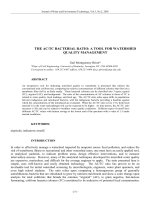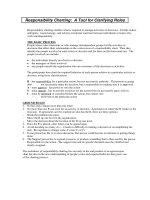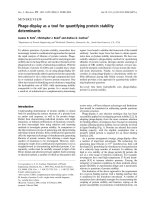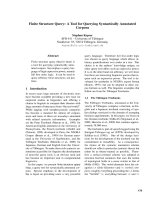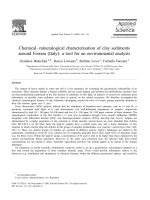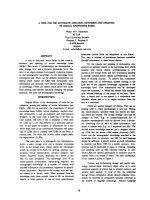The agroforestry field guide: A tool for community based environment education doc
Bạn đang xem bản rút gọn của tài liệu. Xem và tải ngay bản đầy đủ của tài liệu tại đây (7.55 MB, 103 trang )
ACKNOWLEDGEMENTS
This book and the other books in this series are dedicated to Nguyen My Hanh, a dear
friend whose passion, devotion, and love for humanity have inspired every page.
Publication of this book would not have been possible without the support of several
institutions and individuals. We owe particular thanks to WWF UK for financial support
of this book. Special thanks also to Pham Hong Nguyen and Do Huong Giang, whose
contributions to the book are highly appreciated, to Wendy Tubman for editing in English,
to all the staff involved in the Central Vietnam Tiger Corridor Project at the Forest
Protection Department branches at Quang Nam, Kon Tum, and Thua Thien Hue, who
have been great working partners; and to Erika Gildersleeve for her hard work and
creativity in designing the book. Thanks also to the following organizations and individu-
als in them who have helped in the process of gathering information and assisted during
field visits: the Division of Agriculture and New Economics of Tam Diep town (Ninh Binh
Province), the Upland Agriculture Board for Social Forestry and Nature Conservation
Project of Nghe An Province, Division of Agriculture and Rural Development of Tinh Gia
District (Thanh Hoa Province), Eco-Eco, Vietnam Agricultural Scientific Institution, CARE,
GTZ/Song Da Social Forestry Project, FAO, Oxfam-UK, SNV, and Mr.Nguyen Van Cuong,
Labor Hero, Soc Son District (Hanoi)
Agr-chance.qxd 4/25/03 1:28 PM Page III
Introduction 3
I. The Tree Nursery 9
Site Selection 12
Nursery Layout and Preparation 13
Seed Collection and Viability Testing 14
Calculating the Seed Requirement 14
Seed Treatment 15
Soil and Organic Material Preparation 16
How to Make Compost 18
How to Prepare Manure 20
Starting Seedlings 20
Making and Using Seedbeds 21
Making and Using Seedboxes 21
Making And/Or Using Seedling Pots 22
Shade 23
Pricking Out and Transplanting 23
Hardening Off and Planting Out 24
Root Pruning 26
Seedling Management
(Water, Weeding, Pest Management) 27
Vegetative Propagation Techniques 28
II. Agro Forestry Technologies 33
Living Fence 37
Fodder 38
Woodlots 39
Multipurpose Tree Gardens 39
Orchards 44
Taungya 44
Systematic Tree Intercropping 45
Making and Using an A-Frame 47
Contour canal 48
Bench Terracing 49
Contour Vegetation Hedgerows 50
Alley Cropping 51
Improved Fallow 52
Undersowing 53
III. Agro forestry Species 55
Appendix A: Species Use and Planting 106
Appendix B: Recommended Tree Spacing 108
Bibliography 109
Table of Contents
Agr-chance.qxd 4/25/03 1:28 PM Page V
PHOTO: TILO NADLER
Introduction
Photo above:
Forest of Song Thanh Nature Reserve, Quang
Nam Vietnam
Inset Photos:
Cat Ba Langur
Saola
Agr-chance.qxd 4/25/03 1:28 PM Page 3
- THE AGROFORESTRY FIELD GUIDE: A TOOL FOR COMMUNITY BASED ENVIRONMENTAL EDUCATION -
H
uman existence is inextricably linked
to the environment. Throughout the
world, people depend on the exploita-
tion of natural resources. However, circumstances
such as extreme poverty can force individuals to
over exploit these resources in order to survive.
This creates a paradox: To ensure their immediate
survival, humans are using natural resources at a
rate that jeopardizes their future survival. The very
resources upon which human lives depend are
being exploited at an unsustainable rate. Future
unavailability of key resources will lead to further
human poverty and to loss of the very natural
resource heritage that provides us with life and
nurtures our spirits. It is evident that if over
exploitation of natural resources persists at the
present rate, an environmental crisis will lead
directly to a human crisis.
The forests of Vietnam provide sanctuary for an amazing range
of floral and faunal species. Rare and endangered species such
as the Saola (Pseudoryx nghetinhensis) can be found there.
Additionally, seven pheasant species, including the endemic
Edwards Pheasant (Lophura edwardsi), which was thought to be
extinct, and the Crested Argus (Rheinardia ocellata), which is
also endemic to the region, are found in these forests. The
forests of Vietnam are also home to many rare primates, includ-
ing gibbons (Hylobates sp.) and three species of Douc Langur
(Pygathrix sp.). At least six species of primate, including the Cat
Ba Langur (Trachypithecus poliocephalus), the Delacours Langur
(Trachypithecus delacouri), and the Tonkin Snub Nosed Monkey
(Pygathrix avunculus), are endemic.
Agr-chance.qxd 4/25/03 1:28 PM Page 5
6
Numerous other highly threatened fauna, including wild cattle such as the Gaur (Bos
gaurus
), the Javan Rhinoceros (Rhinoceros sondiacus annamiticus), the Indochinese Tiger
(Panthera tigris corbetti), the Asiatic Black Bear (Ursus thibetanus), the loris (Nycticebus
spp.
) and the Asian Wild Dog (Cuon alpinus), are found in these forests.
However, this rich and unique biodiversity is declining rapidly. This is partly due to the fact
that the country is heavily dependent upon natural resources, with agriculture, forestry and
fisheries accounting for more than 80 per cent of total employment in the country. A fast
growing population further exacerbates the pressure on the environment. At the 1999
annual growth rate of 2 per cent, the country's population of 77 million will double every
34 years. In the uplands, population pressure is rendering traditional
agricultural systems unsustainable, and the traditional rotation/fallow period has, in some
places, been shortened by two-thirds. The shorter fallow period exhausts the land more
quickly and requires more forest to be cleared to create new, productive fields. The high
levels of deforestation and intensive cropping practices lead to soil erosion, lowland
flooding, and soil infertility, all of which increase the insecurity of food supplies. Illegal
trade in wildlife, unsustainable hunting and fishing, and the collection of non-timber
forest products also contribute to the degradation of the ecosystem, even though these
activities supplement incomes.
Long-term conservation of the natural world cannot be achieved unless each individual
takes responsibility for protecting it. In most cases this requires a change in behaviour. In
order to change their behaviour and participate in conservation, individuals need
three things. First of all, they need to see and acknowledge the problems they and their
environment are facing. Secondly, they need to realize the benefits of changing their behav-
iour and the consequences of a failure to change. And thirdly, they need to have an alterna-
tive to behaviour that negatively affects the environment, and this alternative needs to pro-
vide them with benefits comparable to those that they currently receive.
Potentially, agroforestry can target the current threats to the environment while meeting
the human needs of rural communities. For farmers currently using swidden agriculture, agro-
forestry technologies such
as contour hedgerows,
improved fallow and alley
cropping offer increased soil
fertility and better soil
and water conservation.
These techniques improve
crop yields and food securi-
ty while limiting the need to
abandon old fields and cut
forest in search of more
productive ones.
- THE AGROFORESTRY FIELD GUIDE: INTRODUCTION -
Agr-chance.qxd 4/25/03 1:28 PM Page 6
7
Illegal timber extraction from the forests is a common way to increase incomes and meet
domestic demands for wood; woodlots on the farm can provide an alternative to this practice.
Communities collect non-timber forest products (NTFP’s) from the forest to supplement their
incomes and diets.
Establishing agroforestry systems such as multi-storied home gardens, with species that are
valued for domestic use and for sale in domestic and international markets as well as for soil
protection and soil regeneration, offer a good alternative to harvesting from natural forests.
Furthermore, hunting is a common practice to increase incomes and to supplement diets;
income from the sale of different agroforest products can both increase household incomes and
enhance local diets thus reducing the need for subsistence hunting.
This training guide equips the extension officer with a comprehensive set of tools with
which to train others in agroforestry practices. It has two goals. One goal is to help
extension officers work with communities in action-oriented environmental education
programmes. The other goal is to provide communities with the skills required for practising
livelihoods that have a benign, or ideally, a beneficial, impact on the natural world.
The guide has three sections: I. The Tree Nursery; II. Agroforestry Technologies; and III.
Agroforestry Species. Technical information with easy to understand illustrations and photos
on how to establish agroforestry systems that contribute to the livelihoods of communities liv-
ing in and around protected forest areas while conserving natural resources are provided in
these sections.
This book is one of a series developed by the Environmental Education Programme of WWF
Indochina in conjunction with the Forest Protection Departments of Quang Nam, Thua
Thien Hue, and Kon Tom provinces. Three other books are included in this series:
Environmental Education: A Training Guide for Practitioners; Discovering Nature: An
Activity Guide for School Children; and Monitoring and Evaluation for Community Based
Environmental Education Programmes. The books provide governments, non-government
organizations, and donors with alternatives for conservation that can be integrated into
environmental plans and policies.
- THE AGROFORESTRY FIELD GUIDE: A TOOL FOR COMMUNITY BASED ENVIRONMENTAL EDUCATION -
Agr-chance.qxd 4/25/03 1:28 PM Page 7
SECTION ONE
The Tree Nursery
Photo above:
Example of a
living fence used in a nursery
Inset Photo:
Leguminous shrub used for fodder
Agr-chance.qxd 4/25/03 1:28 PM Page 9
N
urseries are essential for anyone inter-
ested in establishing agroforestry sys-
tems. They are the starting point for the
tree that will take on a life in the field. Farmers can
use nurseries to propagate seedlings either by vege-
tative methods or by seed. Careful planning and
design of a nursery is important if high quality
seedlings that will yield the best results in the field
are to be raised. This section provides the necessary
technical information to establish such a productive
and healthy nursery.
FIGURE 1
C
GCFE
B
A
D
60 cm
NURSERY LAYOUT
The letters, A - G, pictured in this diagram correspond to the letters in Figure 2
- THE AGROFORESTRY FIELD GUIDE: A TOOL FOR COMMUNITY BASED ENVIRONMENTAL EDUCATION -
Agr-chance.qxd 4/25/03 1:28 PM Page 11
12
- SECTION ONE: THE TREE NURSERY -
1.1 SITE SELECTION
The first and most important step in building a successful nursery is to find a suitable site
for it. There are various criteria to keep in mind when selecting this site. (See figures 1
and 2 for example of nursery layout) It should:
k be close to a stream or near a readily accessible source of water
such as a well
k be in an area that is easily accessible and convenient to get to
(such as close to the house or the farm)
k have good soil, sand and compost or manure, or be convenient
to a source of these things
k be reasonably flat or terraced (a large slope will make it difficult
for the seedlings to stand upright and will be prone to water flow
that can destroy the seedlings)
k be large enough to accommodate the plants (roughly 10m x 10m
for every 5,000 plants), and to provide areas for working, for seedbeds,
and for storage of soil and organic material
k have shade in the work area to protect both workers and plants
k have a fence, ideally a living fence and be located in an area that is
protected from strong winds.
CRITERIA FOR
BUILDING A SUITABLE
NURSERY SITE
Pictures A - G in this figure
are an enlarged view of the letters
shown in Figure 1
Easily accessible and flat or terraced
Accessible source of water Fenced and protected from wind Good soil, sand, and compost
Rows of seedlings with shade
A. B.
D.C.
E.
G.
F.
FIGURE 2
Agr-chance.qxd 4/25/03 1:28 PM Page 12
13
1.2 NURSERY LAYOUT AND P REPARATION
Once the site has been selected, clear away any stumps, roots or large stones that might
interfere with the location of the seedlings. If the site has a steep slope (greater than ten
degrees), level or terrace it. Make terraces at least 5m wide to allow enough space for
seedlings or seedbeds. To prevent erosion and runoff, plant binding grasses on terrace edges.
Once this is done it is important to build a fence around the nursery to keep out strangers
and animals and to provide some shade. Plan the layout of the nursery so that there is a
suitable place for seedbeds, potted seedlings, soil, sand, compost or manure, and a work
area with shade. Construct seedbeds as in figure 10. As a general guide, make seedbeds
about 80-100cm wide so that you can reach all the seedlings when weeding and watering.
Make walkways between rows of potted seedlings wide enough for comfortable access. To
facilitate counting and to provide for better management, arrange pots in even numbers (for
example, in groups of 10 or 20 pots wide and 50 or 100 pots long). (See figure 3) If possible,
orient the rows of plants lengthwise east to west so that all plants in the rows receive uni-
form amounts of light.
- THE AGROFORESTRY FIELD GUIDE: A TOOL FOR COMMUNITY BASED ENVIRONMENTAL EDUCATION -
FIGURE 3
50- 100 Pots Long
10-20 Pots Wide
0.6m
Agr-chance.qxd 4/25/03 1:28 PM Page 13
14
1.3 SEED C OLLECTION AND V IABILITY TESTING
After the site is selected and prepared the next step is to collect or buy the seed of the
desired tree species to be planted. When fruit is ripe, collect seeds from at least 30 mature,
healthy, vigorous trees. Store seeds in a cool, dry place to avoid loss of viability. Remember
that some seeds can be stored for much longer than others and some cannot be stored at
all. To check seed viability, carry out the following simple test. (See figure 4) Cut a rectangu-
lar plastic container lengthwise so that the closed face lies flat on a table. Lay wire mesh
over the open face of the container, and lay cotton or cloth on the mesh. Soak the cloth or
cotton with water and lay about 100 seeds on the material. Keep the cloth constantly wet
by spraying it with water when necessary so that the seeds remain moist. Leave the seeds
like this until they begin to germinate. Count how many seeds germinate. If you laid 100
seeds on the germination tray and only 25 germinated, the germination rate is about 25 per
cent. In this case, plant four seeds in each pot.
1.4 C
ALCULATING THE S EED REQUIREMENT
To calculate seed requirements a farmer should know the number and species of trees
needed, the size of the area to be planted and the desired spacing between the trees.
Farmers should also know how many seeds there are in 1kg for the particular species being
planted, and the germination rate of that species. Conducting the test above (refer to section
1.3) can establish the germination rate. Let’s look at an example and calculate the amount
of seed required. A farmer wants to plant a green manure bank measuring 1,000m x 500m
with Gliricida sepium.
- SECTION ONE: THE TREE NURSERY -
SEED COLLECTION
AND VIABILITY
TESTING
Cut plastic container lengthwise
Lay approx. 100 seeds on
water-soaked material
Constantly moisten cloth with water Leave seeds in container
until germination
Lay wire mesh over cut container,
lay cotton or cloth over mesh
A. B.
D.C. E.
FIGURE 4
Agr-chance.qxd 4/25/03 1:28 PM Page 14
15
All the trees must be at least 2m apart. That is, the spacing is to be 2m x 2m. G. sepium has
7,000 seeds per kilogram. The seed the farmer wants to use has a 70 per cent germination
rate. Note that the amount of seeds required will depend on the number of seedlings to be
planted out and that this will partly depend on the shape of the block of land and whether
or not trees can be planted right on the boundaries of the land. In most cases, the calcula-
tion will be close to accurate if you divide the total area of land (in this case, 1,000m x
500m, or 500,000m
2
) by the amount of space needed by each tree (in this case 2mx2m, or
4m
2
).
Area = 1,000 x 500m = 500,000 m
2
Spacing = 2m x 2m = 4m
2
Seedlings needed = Area/Spacing = 500,000m2/4m
2
= 125,000
Additional seeds needed to make up for the 30% of seeds that will
not germinate = 30% x 125,000 = 37,500
Total number of seeds needed = 125,000 + 37,500 = 162,500
As there are 7,000 G. sepium seeds per kilogram, the required 162,500 seeds
will weigh 162,500/7,000kg = 23.21kg
Therefore, a total of 23.21 kg of seeds is required for the area to be planted.
1.5 SEED T REATMENT
To improve and speed up germination rates, use one of the
four treatments described below. (See figure 5 for more details
on water treatment methods) After treatment, plant the seeds
immediately.
1. Cold water treatment: Place seeds in a cloth or
sock and immerse in cold water for 12-48 hours.
2. Hot water treatment: Boil water in a pot and
remove from the heat for 10 to15 minutes. Place the
seed in a cloth or sock and soak in the water for up
to two days.
3. Boiling water treatment: Boil water in a pot and
remove from the heat. Put the seed in a cloth or sock
and place in the water for two minutes. Pour out the
hot water and replace with cold water. Leave the
seeds immersed for up to two days.
4. Scarification: Use sandpaper to scarify the end of
the seed coat where the root will emerge.
(Generally, this end has an indentation.) Be careful
not to damage the seed itself.
- THE AGROFORESTRY FIELD GUIDE: A TOOL FOR COMMUNITY BASED ENVIRONMENTAL EDUCATION -
Immersing seed in water
Placing the seed in a cloth
WATER
TREATMENT
METHODS
FIGURE 5
Agr-chance.qxd 4/25/03 1:28 PM Page 15
16
1.6 SOIL AND ORGANIC M ATERIAL PREPARATION
Plant growth is highly dependent on the texture and nutrient content of the soil. Soil texture
can range from sticky clay to gritty sand. Sticky clay is not good for drainage and aeration.
Sandy soil does not retain enough water and nutrients for optimal plant growth. The best soil
for most seedlings is neither sticky nor sandy but somewhere in between, allowing for reten-
tion of water, good drainage and aeration. (See figure 7)To get such texture, it may be neces-
sary to adjust the soil content. If the soil is hard clay, add compost and sand in
proportions of 2:2:1 (soil:compost:sand). If the soil is medium-textured, add both compost
and sand in proportions of 1:1:1. If the soil is sandy, add only compost at a ratio of 1:1.
(See figure 6)
Organic material in soil provides the nutrients essential for good plant growth. The two most
common sources of organic material for use in the nursery are compost and animal manure.
- SECTION ONE: THE TREE NURSERY -
SOIL COMPOSITION
If soil is hard clay, add compost and sand in proportions of 2:2:1 (soil:compost:sand).
If soil is medium-textured, add both compost and sand in proportions of 1:1:1.
Soil Sand Compost
FIGURE 6
Agr-chance.qxd 4/25/03 1:28 PM Page 16
17
- THE AGROFORESTRY FIELD GUIDE: A TOOL FOR COMMUNITY BASED ENVIRONMENTAL EDUCATION -
SOIL TEXTURE AND NUTRIENT CONTENT
CLAY
Sticky clay
GOOD DRAINAGE
Somewhere in between sticky clay and loose sand
FIGURE 7
Agr-chance.qxd 4/25/03 1:28 PM Page 17
18
1.7 HOW TO M AKE COMPOST
Compost is the name given to organic matter (such as vegetables, fruit, leaves and grass)
that has been broken down by bacteria, insects and fungi into a nutrient-rich material.
Compost can be used by plants as fertilizer. The process of making compost can take from
40 days to four months.
To make compost, gather a number of different organic materials, such as grass, fruit skins,
vegetable matter, sugar cane, corn or rice husks, weeds, or leaves from leguminous plants
such as Leucaena leucocephala or Tephrosia candida. Break or chop the material into small
pieces (1-2cm). Put the pieces in a pile. Pour water on the pile (the microorganisms that are
working on the pile of organic waste and turning it into compost rely on water and oxygen to
survive). Turn the pile every few days and sprinkle it with water every so often to keep it from
drying out. It should remain moist but not soaked. Over watering it can kill the microorgan-
isms. The content of the pile should be about 50 per cent water. When you squeeze a clump
with your hand, it should feel wet but water shouldn’t drip out.
There are two types of microorganisms that digest the organic material both of which raise
the temperature of the pile. The first type raises the temperature to 50 degrees centigrade.
After this, the temperature will autonomously increase to 65 degrees centigrade, at which
point the first organisms will die off and organisms adapted to high heat will take over and
continue to break down the materials. These temperature-tolerant organisms will raise the
temperature to a peak of 70 degrees centigrade. The longer the temperature stays at 55-65
degrees centigrade, the faster the compost will be made.
One system for making compost that is recommended by the World Agroforestry Centre,
formally called the International Centre for Research in Agroforestry (ICRAF), is called the
‘three bed system’. To construct this system you will need some wood or bamboo sticks. First,
make a rectangular frame about 30cm high, 1.5m wide and 3m long. (See figure 8) Lay the
bamboo or wooden poles on the frames to form a base leaving holes big enough for air to pass
through for ventilation but not so big that the organic
matter and compost can fall through. Be careful not to
use material that rots quickly or the bed will collapse.
Make three of these frames side by side about 1m
apart. Pile the chopped organic waste onto two beds to
a height of about 1m, leaving the centre bed empty for
now. (See figure 9A) After a week, check the tempera-
ture of the piles by sticking your hand in them. Check them
again in about two weeks; they should have cooled down.
With a pitchfork, mix each pile so that it becomes loose and
the material at the bottom is exposed to the air. After two more
weeks, remove the outside layer of
material from each pile and put it on the centre bed.
- SECTION ONE: THE TREE NURSERY -
FIGURE 8
30 cm 1.5m
3m
Agr-chance.qxd 4/25/03 1:28 PM Page 18
(See figure 9B) Over time, remove all material from the outer layer of the piles and place it on
the centre bed on top of the other material. Continue to do this until all the material has been
moved from the outer beds to the center bed. (See figure 9C) Mature compost will have only
about one-fifth of the volume of the original organic material from which it was made. You can
now begin the process again by placing fresh organic material on the outside beds. After about
four weeks, move the material from the centre pile to a storage area and leave it to mature.
When it is mature, you should not be able to see any chunks of organic matter (such as bark
or leaves) in the pile. To check that the compost is ready to use, wait until the
compost is light brown and looks like ground coffee. Then put two handfuls of moist compost
into a plastic bag and leave it in a cool, dark place for 24 hours. Open the bag. If there is no
gaseous smell, the compost is ready. If there is a gaseous smell, leave the pile for a few more
days and then test again. If compost is used before it is ready, it may burn the plant or it may
lack the essential nutrients required by the plant for healthy growth. (WIGHTMAN, 2000)
19
- THE AGROFORESTRY FIELD GUIDE: A TOOL FOR COMMUNITY BASED ENVIRONMENTAL EDUCATION -
B.
C.
THREE BED SYSTEM
A.
Pile chopped organic waste onto two beds to a height of about 1m, leaving the centre bed empty.
After five weeks, remove outside layer of material from each pile and put on centre bed.
Over time, remove all material from outer layer of piles and place on centre bed.
Continue until all the material has been moved from outer beds to centre bed.
FIGURE 9
Agr-chance.qxd 4/25/03 1:28 PM Page 19
20
1.8 HOW TO P REPARE MANURE
Manure is also an important source of plant nutrients and can be added to soil to improve
both texture and fertility. Types of animal manures differ in the amount of nutrients they con-
tain. Chicken manure has a higher nitrogen, phosphorous, and potassium (NPK) content than
any other domestic manure, with a 20:16:9 NPK ratio. Sheep and goat manure have a ratio of
19:7:20; cattle manure has an NPK ratio of 12:3:9; and pig manure has a ratio of 10:7:8.
Prepare and test manure in the same way as you prepare and test compost (refer to section
1.7). Test for readiness after six to ten weeks. (ATIK)
1.9 STARTING SEEDLINGS
Seedlings can be started in three ways. They can be raised in a seedbed and, when
sufficiently mature, planted out in the field; they can be germinated in a seedbox,
transplanted to a pot and then planted in the field; or they can be sown in a pot and
then planted in the field. All three ways have advantages and disadvantages.
Bare-rooted seedlings (those from seedbeds) are easier to transport to the planting site,
require less care in the nursery, and are cheaper because there is no need for pots. However,
they need more space and time in the nursery and are at risk of damage and death when the
roots are exposed to the air after being removed from the seedbed.
Similarly, germinating seeds in a seedbox and then pricking them out and transplanting them
in a pot can often cause the roots to be damaged. The seedlings may also experience shock
from being transplanted and, as a result, growth may slow down.
Finally, while plants sown in pots are heavier to transport to the planting site, and their roots
require careful pruning, they are often easier to care for and will be healthier when ready for
planting in the ground. It is important to select the method most suitable for the species
being grown.
Make a box frame about 60cm wide, 15cm high and 1m
long. Raise poles 1cm off ground for pruning.
Leave 5cm space between outer row of seedlings and frame.
Sow seeds about 5cm apart in furrows.
SEEDBED CONSTRUCTION
FIGURE 10
0.6m
1m
15cm
- SECTION ONE: THE TREE NURSERY -
Agr-chance.qxd 4/25/03 1:28 PM Page 20
21
1.10 MAKING AND U SING SEEDBEDS
To make a seedbed, collect some tree branches or bamboo poles with a combined width of
about 20cm. Lay them down to make a box frame about 60cm wide, 15cm high and 1m
long. (see figure 10) Raise the branches/poles 1cm off the ground so that a machete blade
can be passed underneath when pruning the roots, and secure the poles with pegs. Fill the
frame with good potting soil (refer to section 1.6) so that the soil reaches the top of the frame.
Make furrows 10cm apart along the length of the seedbed. Leave a 5cm space between the
outer row of seedlings and the frame. Sow seeds about 5cm apart from each other in the
furrows. Cover the furrows with soil to a depth of no more than two-thirds the thickness of
the seeds. Water the seedbed and cover with mulch. (BUNDERSON, 1995)
1.11 MAKING AND USING S EEDBOXES
Construct a seedbox with dimensions of about 60cm x 60cm and 10cm deep. Make holes in
the bottom of the box and raise the box on legs to allow for drainage. To provide some sta-
bility and to prevent ants from climbing the legs and attacking the seedlings, stand the legs
in cans filled with water. Cover the bottom of the box with a 3cm layer of gravel and then
fill the box with a rooting medium made of equal parts of soil, sand, and compost. (See fig-
ure 11) Pour
boiling water over the filled box to sterilize it. Make fur-
rows in the soil, place seeds in the furrows (or broadcast
the seeds evenly) and cover them with a fine layer of
soil. Water the box to keep the contents constantly
moist. (ATIK, 1992)
- THE AGROFORESTRY FIELD GUIDE: A TOOL FOR COMMUNITY BASED ENVIRONMENTAL EDUCATION -
FIGURE 11
60 cm
60 cm
Agr-chance.qxd 4/25/03 1:28 PM Page 21
22
1.12 MAKING A ND/OR USING S EEDLING POTS
Polythene pots or folded banana leaves can be used for potting seedlings. The important
thing is that the container should be sufficiently durable to last two to three months. The
bottoms of the pots may be open or closed. However, open ones are preferred as they drain
better and are less likely to cause root deformities. (See figure 12A) If you are using open-
ended pots, wet some soil until it is sticky and push it to the bottom of the pot, filling about
2cm at the bottom. (See figures 12B) This will make a compact seal and prevent the soil
falling through the pot. After this is done, fill the pot to the top with potting soil.
(See figure 12C) The soil will settle, leaving about a 0.5cm gap at the top, which will retain
water when the pots are watered. Insert a stick into the centre of the soil in the pot to the
desired depth (two-thirds the diameter of the seed) and plant the seed in the hole. Water the
pot to keep the soil moist.
- SECTION ONE: THE TREE NURSERY -
Soil should be wet and sticky to create
a compact seal at bottom of pot
FIGURE 12
Open bottomed pots are preferable to ensure good drainage.
They should be durable enough to last 2-3 months.
Fill pot to top with potting soil. Soil will settle leaving
a gap to retain water when pots are watered.
MAKING OPEN-BOTTOMED
SEEDLING POTS
A.
C.B.
Use Polythene pots OR folded banana leaves
Agr-chance.qxd 4/25/03 1:28 PM Page 22
1.13 SHADE
Seedlings need to be shaded from extreme heat. As the plants grow larger and become
stronger, the amount of shade should be slowly reduced, so that when it is time for planting
out they are ‘hardened’ and can survive on their own without shade. (See figure 13) Thatch,
large leaves, rattan or bamboo mats can all be used to provide shade. The shade provided
should not be so dense that no light can enter. One method for hardening plants is to expose
the plants to full sunlight for one hour per day, then for two hours, then three hours and so
on until the plants no longer need shade. Another method is to cut the shade in the nursery
by half after three to four weeks. After another two to three weeks, remove the shade com-
pletely.
1.14 PRICKING O UT AND TRANSPLANTING
If germinating seedlings in seedbeds or seedboxes and then transplanting them
into pots, the seedlings should be ‘pricked out’ once their first two true leaves
have developed. This will generally be when the seedlings are about three to
five weeks old and around 3-8cm tall. The night before transplanting, water
both the soil in the pots and the seedlings in the seedbeds or seedboxes.
When transplanting, work in a well shaded area as direct sunlight can kill
the pricked out seedlings very quickly. Make a hole in the soil in the pot deep
enough for the seedling root, making sure that the hole is straight. Throw
away any poor quality seedlings. Loosen the soil around the seedling and
hold the leaves upward. Squeeze the leaves gently together, and pull the
seedling out of the soil. (See figure 14) Now place the seedling in the pre-pre-
pared hole in the pot, making sure it is straight. Water the pots immediately
after transplanting and place under the constructed shade.
- THE AGROFORESTRY FIELD GUIDE: A TOOL FOR COMMUNITY BASED ENVIRONMENTAL EDUCATION -
FIGURE 14
FIGURE 13
Agr-chance.qxd 4/25/03 1:28 PM Page 23
1.15 HARDENING O FF AND PLANTING OUT
Before trees can be successfully planted in the field they should be hardened
off. This means that they should gradually be given less water and less shade,
so that by the time they are ready for planting they will be able to withstand
the natural environment with minimal care. Once the shade has been gradually
removed (refer to figure 13), gradually reduce watering from twice to once per
day. This should be done four to six weeks before planting out. After another
week, reduce watering to once every other day until the time for planting out. It
is also important to increase root pruning to once a week before planting out
(refer to section 1.16). Do not plant out any plants that look deformed or
unhealthy. Throw them away.
Plant out at the start of rains, and ideally on a wet day. Plant out during the
early morning or evening to avoid extreme heat. Most trees are ready for
planting out when the stems of the trees are equal in length to the roots, and
both stems and roots are about 20cm long. (See figure 17A) Carry the potted
seedlings to the site and remove the pot by cutting off the bottom 1cm of the pot and mak-
ing a slit down the side. (See figure 17B) For seedlings in seedbeds, remove the seedlings by
cutting squares around them and carefully lifting them and the square of soil out of the
bed. (See figure 17C) Keep the seedlings moist and wrapped in leaves or put in a basket and
cover with a wet cloth to protect them from the sun. At the site, dig holes measuring 30cm
deep and 30cm in diameter. (See figure 15) Place the subsoil (A in the figure) and the topsoil
(B in the figure) in two different piles. Mix the topsoil with equal amounts of manure (C in
the figure) and put the mixture back in the bottom of the hole. Place the seedling at the
center of the hole, keeping the root collar level with the ground. (See figure 17 for proper and
incorrect planting methods.) Replace the subsoil at the top of the hole and pack the
soil firmly around the seedling. Water the seedling. Add mulch to prevent weeds from
establishing and water evaporating. If necessary, construct a small enclosure around the
tree to protect it from browsing animals. (See figure 16)
24
- SECTION ONE: THE TREE NURSERY -
FIGURE 15
PROTECTIVE SEEDLING ENCLOSURES
FIGURE 16
Agr-chance.qxd 4/25/03 1:28 PM Page 24
- THE AGROFORESTRY FIELD GUIDE: A TOOL FOR COMMUNITY BASED ENVIRONMENTAL EDUCATION -
Too high Too deep
Slanted
Soil not packed Hole to small
Correct
PLANTING METHODS
A. B. C.
FIGURE 17
Agr-chance.qxd 4/25/03 1:28 PM Page 25
26
1.16 ROOT PR UNING
Root pruning helps to produce robust root systems and to prevent
roots growing into the ground in the nursery. Three methods for root
pruning are discussed here. The first is root pruning in the seedbed.
To prune the root in this situation, use a machete or long blade to
cut vertical rows through the soil between all seedlings in the bed.
After this, run the machete along the ground under the seedbed
from all four sides.
For seedlings in pots, simply move the pots every once in
a while. This will prohibit any root growth. (See figure 19)
Prune the root every two to three weeks and three to four
days before planting out.
The third method of root pruning is air pruning. Only some species can be pruned in this
manner so the farmer should test this with a small amount of seedlings first. Make a plat-
form with wire mesh laid on some brick or logs. (See figure 18) Lay the seedlings on top of
the mesh. As soon as the roots make contact with the air, they cease growing vertically and
form fine lateral roots.
FIGURE 18
FIGURE 19
- SECTION ONE: THE TREE NURSERY -
Agr-chance.qxd 4/25/03 1:28 PM Page 26
27
1.17 SEEDLING M ANAGEMENT (WATERING, WEEDING, CONTROLLING PESTS)
Water new seedlings twice a day. As climate and soil differ from place to place, seedlings
raised in some areas may require more (or less) watering than seedlings raised in other
places. The general rule is to give plants enough water to maintain turgidity in the leaves. If
the leaves begin to wilt, they are not being watered enough. To avoid over watering, allow
the soil to dry out slightly before watering again. It is best to water in the early morning or
late afternoon when it is cool. Water so that the soil becomes completely wet and water
begins to run out the bottom of the pot.
Weeding plants in the nursery is also important. Weeds compete for the nutrients and
water that the seedlings need to thrive. Clear weeds often and discard the weeds in a com-
post pile.
To control pests, keep things tidy, sterilize equipment before use, and destroy diseased
plants. Some natural, plant-based products can also be used to minimise insect and fungi
attacks. Some common ones are suggested below.
Neem (Azadirachta indica) This tree can be used as a fungicide, insecticide and
bactericide. Wash and remove the husks of mature seeds and allow the seeds to dry
completely. Take 12 handfuls of seeds and grind into a fine powder. Mix the powder in
12 litres of water and soak overnight. Strain the liquid and apply.
Custard apple (Annona Squamosa, A. muricata) This fruit can be used as an insecticide.
Collect two handfuls of seed and dry them. Grind the seeds into a fine powder and mix
with 4 litres of water. Soak overnight. Strain the liquid and apply.
Chilli pepper (Capsicum frutescens) This can be used as an insecticide. Collect two
handfuls of chilies and dry them. Grind the chilies into a fine powder and mix with 2
litres of water. Soak overnight. Strain the liquid and apply.
Gliricidia (Gliricidia sepium) Roots, seeds, and leaves can be used as an insecticide or
to prevent rats from eating seedlings. Mix 300g of dry plant material with 1 litres of
water and soak for 24 hours. Strain the liquid and apply.
Papaya (Carica papaya) This can be used as a fungicide. Finely chop 1kg of dry leaves
and mix with 1 litres of water and soak overnight. Dilute with 4 litres of water and
apply to the soil and to the bottom of leaves.
Garlic and onion (Allium sativum, A. Cepa) This mixture can also be used as an effec-
tive pesticide. Mix 500g of finely chopped material in 10 litres of water. Allow to fer-
ment for one week. Dilute with another 10 litres of water and apply to the soil.
(WIGHTMAN, 2000)
- THE AGROFORESTRY FIELD GUIDE: A TOOL FOR COMMUNITY BASED ENVIRONMENTAL EDUCATION -
Agr-chance.qxd 4/25/03 1:28 PM Page 27

